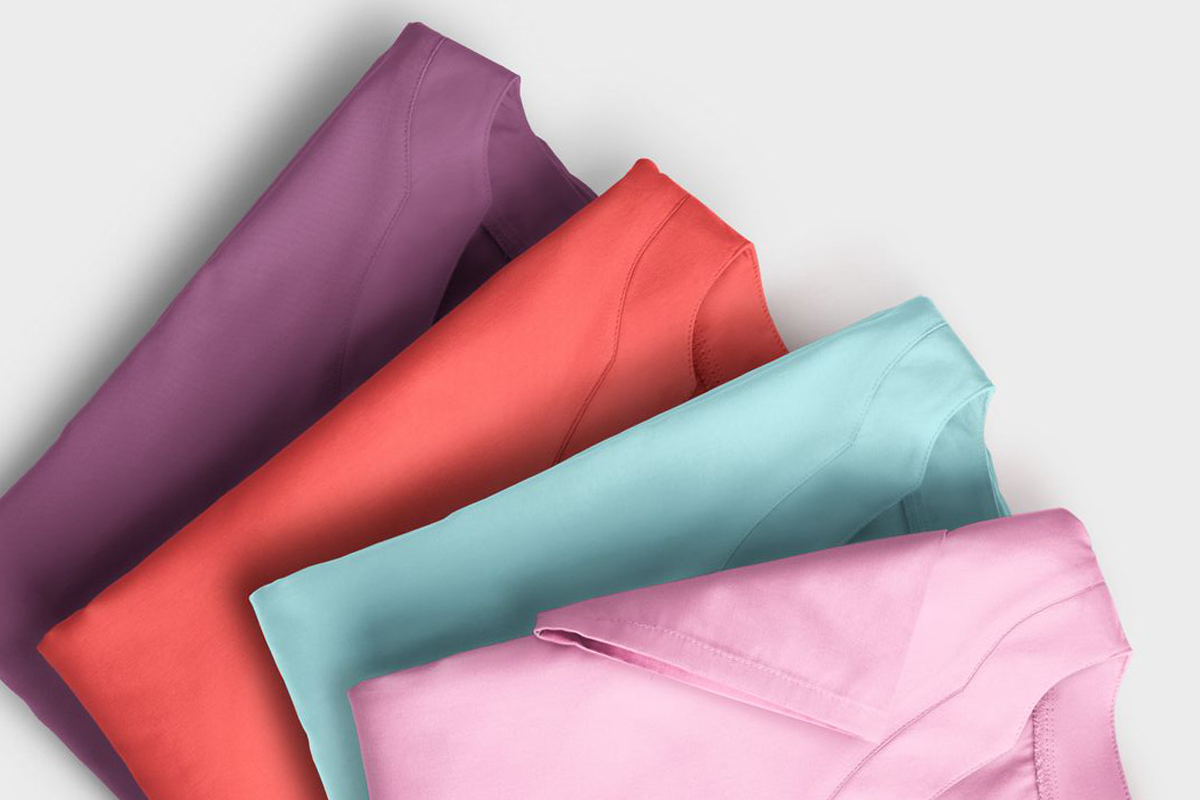Certified Medical Wear Fabrics – What to Pay Attention to?
 When choosing medical wear fabric, I always focus on certified fabrics to ensure safety and hygiene in rigorous healthcare settings. For instance, TR fabric is an excellent choice due to its durability and comfort, perfectly suited for medical applications. Moreover, high end color fastness fabric retains its vibrant appearance even after numerous washes. By opting for certified fabrics, you can trust that they meet industry standards, providing protection for both patients and healthcare professionals.
When choosing medical wear fabric, I always focus on certified fabrics to ensure safety and hygiene in rigorous healthcare settings. For instance, TR fabric is an excellent choice due to its durability and comfort, perfectly suited for medical applications. Moreover, high end color fastness fabric retains its vibrant appearance even after numerous washes. By opting for certified fabrics, you can trust that they meet industry standards, providing protection for both patients and healthcare professionals.Key Takeaways
- Prioritize certified fabrics to ensure safety and hygiene in healthcare settings, as they meet stringent industry standards.
- Look for materials with antimicrobial and fluid-resistant properties to enhance patient safety and protect healthcare workers from exposure.
- Choose fabrics that offer breathability and moisture-wicking features to keep healthcare professionals comfortable during long shifts.
Importance of Certified Fabrics
Why Certifications Are Crucial
I always prioritize certified fabrics when selecting materials for medical wear. Certifications act as a guarantee of quality, safety, and compliance with industry standards. In healthcare environments, where hygiene and safety are paramount, certified fabrics provide peace of mind. They ensure that the materials meet stringent requirements for performance and reliability. For example, fabrics with advanced antimicrobial properties help reduce the presence of pathogens on surfaces, which is vital for infection control. Without proper certifications, there’s no assurance that the fabric can withstand the demands of medical use.
Common Certifications for Medical Wear (e.g., ISO, FDA, CE)
Understanding common certifications helps me make informed decisions. ISO certifications, such as ISO 13485, focus on quality management systems for medical devices, including fabrics. FDA approval ensures that the material is safe for use in healthcare settings. CE marking indicates compliance with European health, safety, and environmental standards. Additionally, certifications like SGS and OEKO-TEX validate that the fabric is free from harmful substances and safe for prolonged skin contact. These certifications collectively ensure that the fabric is impermeable, durable, and easy to clean, making it suitable for medical applications.
How Certified Fabrics Ensure Safety and Quality
Certified fabrics play a critical role in maintaining safety and quality in healthcare. They undergo rigorous testing to ensure they meet specific criteria, such as fluid resistance, breathability, and antimicrobial effectiveness. For instance, Greenguard-certified fabrics improve indoor air quality by minimizing chemical emissions. Their durability and light resistance make them ideal for repeated use in demanding environments. By choosing certified fabrics, I can trust that the material will perform consistently, protecting both patients and healthcare workers from potential risks.
Key Material Properties
Breathability and Moisture-Wicking Features
I always prioritize fabrics with excellent breathability and moisture-wicking capabilities for medical wear. These features ensure that the material allows air to circulate freely, preventing heat buildup during long shifts. Moisture-wicking fabrics draw sweat away from the skin, keeping healthcare professionals dry and comfortable. This is especially important in high-pressure environments where maintaining focus is critical. For instance, polyester blends often excel in these areas, offering both durability and effective moisture management.
Tip: Look for fabrics tested for breathability to ensure they meet the demands of active healthcare settings.
Antimicrobial and Fluid-Resistant Properties
Antimicrobial and fluid-resistant properties are non-negotiable in medical fabrics. These features reduce the presence of pathogens, prevent microbial contamination, and provide a reliable barrier against bodily fluids. This enhances patient safety while protecting healthcare workers from potential exposure. I often choose certified fabrics with these properties because they meet stringent safety standards. For example, OEKO-TEX-certified materials ensure the fabric is free from harmful substances while offering robust antimicrobial protection.
- Reduces the presence of pathogens.
- Prevents microbial contamination.
- Provides effective barrier protection against bodily fluids, enhancing patient safety and comfort.
Hypoallergenic and Skin-Friendly Materials
Skin-friendly materials are essential for medical wear, especially for those with sensitive skin. Hypoallergenic fabrics minimize the risk of irritation or allergic reactions, ensuring comfort during extended use. I recommend fabrics like cotton blends or those certified by SGS, as they are rigorously tested for skin compatibility. These materials not only feel soft but also maintain their integrity after repeated washes, making them ideal for healthcare environments.
Note: Always verify that the fabric has been tested for hypoallergenic properties to avoid potential skin issues.
Durability and Maintenance
Long-Lasting and Reusable Fabrics
I always look for fabrics that can withstand repeated use without compromising their performance. Reusable medical textiles often endure over 50 commercial laundry cycles, making them a sustainable and cost-effective choice. Their durability ensures they maintain essential properties like fluid resistance and antimicrobial effectiveness even after extensive washing. However, I’ve noticed that laundering can impact barrier properties, especially in thinner fabrics. Thicker materials with higher repellency tend to perform better over time. This is why I prioritize certified fabrics, such as those tested by SGS or OEKO-TEX, to ensure they meet durability benchmarks while remaining safe for healthcare use.
Tip: Choose reusable fabrics with proven longevity to reduce waste and maintain consistent protection.
Single-Use vs. Reusable Options
When deciding between single-use and reusable fabrics, I always weigh the cost and practicality of each option. Disposable textiles may have lower upfront costs, but they often become 4–10 times more expensive on a per-use basis. Reusable materials, while initially pricier, save money in the long run. For example, one hospital saved $100,000 annually by switching to reusable gowns. The table below highlights the cost differences:
| Cost Component | Disposable Textiles | Reusable Textiles |
|---|---|---|
| Direct Purchasing Costs | Lower | Higher |
| Setup and Changing Costs | Higher | Lower |
| Handling and Laundry Costs | N/A | Higher |
| Storage and Inventory Costs | N/A | Higher |
| Disposal Costs | Higher | N/A |
Reusable options also align better with sustainability goals, reducing medical waste significantly.
Cleaning and Sterilization Requirements
Proper cleaning and sterilization are critical for maintaining the integrity of medical fabrics. I always ensure that reusable textiles meet healthcare standards for disinfection. Certified fabrics, like those with OEKO-TEX approval, are designed to withstand high-temperature washing and chemical treatments without degrading. However, I’ve observed that improper laundering can weaken fabric fibers, reducing their effectiveness. Following manufacturer guidelines for cleaning helps preserve their protective properties and extends their lifespan.
Note: Always verify that the fabric’s certifications include testing for repeated sterilization to ensure long-term reliability.
Comfort and Fit
Flexibility and Ergonomic Design
I always prioritize flexibility and ergonomic design when selecting medical wear fabrics. Healthcare professionals often work long hours, performing tasks that require a wide range of motion. Fabrics with stretch properties, such as spandex blends, allow garments to move with the body rather than restrict it. This flexibility reduces strain and enhances comfort during physically demanding shifts. Certified fabrics, especially those tested by SGS, ensure that the material maintains its elasticity without compromising durability. Ergonomic design also plays a key role. Features like gussets and articulated seams improve mobility, making it easier to bend, stretch, or lift without discomfort.
Tip: Look for fabrics with built-in stretch and garments designed with healthcare tasks in mind to maximize functionality.
Proper Fit for Mobility and Functionality
Proper fit is essential for ensuring both mobility and functionality in medical wear. I always recommend choosing garments tailored to the specific needs of healthcare roles. For example, scrubs with adjustable waistbands or drawstrings provide a customizable fit, while fitted cuffs prevent sleeves from interfering with tasks. Loose or ill-fitting clothing can hinder movement and pose safety risks, especially in high-pressure environments. Certified fabrics, like those approved by OEKO-TEX, maintain their shape after repeated washes, ensuring a consistent fit over time. A well-fitted garment not only enhances performance but also boosts confidence during demanding shifts.
Balancing Comfort with Practicality
Balancing comfort with practicality is a constant consideration in medical wear. I often choose lightweight fabrics that feel soft against the skin while offering essential protective features like fluid resistance. Breathable materials, such as polyester-cotton blends, provide comfort without sacrificing durability. Practicality also means selecting fabrics that are easy to clean and quick to dry, ensuring they are ready for use after sterilization. Certified fabrics strike this balance perfectly, meeting safety standards while delivering the comfort healthcare professionals need to perform their best.
Note: Always verify that the fabric combines comfort with essential protective properties to meet the demands of healthcare settings.
Compliance with Healthcare Standards
Understanding Healthcare Regulations
I always ensure that the fabrics I choose comply with healthcare regulations. These rules exist to protect patients and staff by maintaining high standards of safety and hygiene. For example, ISO certifications like ISO 13485 confirm that the fabric meets strict quality management criteria. FDA-approved textiles guarantee safety for medical use, while CE marking ensures compliance with European health and safety standards. I’ve noticed that non-compliance can lead to serious risks, such as infection outbreaks or legal penalties. Staying informed about these regulations helps me select materials that meet the demands of healthcare environments.
Ensuring Workplace Safety and Hygiene
Workplace safety and hygiene depend heavily on the quality of medical wear fabrics. I always prioritize materials with antimicrobial and fluid-resistant properties to reduce the risk of contamination. For instance, porous fabrics can compromise infection control, especially in busy healthcare settings. Certified fabrics, such as those tested by SGS or OEKO-TEX, provide reliable protection against pathogens and bodily fluids. Proper maintenance also plays a critical role. Over-bleaching or improper cleaning can degrade certain materials, reducing their effectiveness. Following manufacturer guidelines ensures that the fabric retains its protective properties over time.
Choosing Trusted Suppliers for Certified Fabrics
Selecting the right supplier is just as important as choosing the fabric itself. I follow specific criteria to ensure I work with trusted suppliers:
- Manufacturing capability: I verify that the supplier can produce fabrics with essential features like flexibility and chemical resistance.
- Logistic constraints: I prefer suppliers with a local presence to minimize transit times and ensure timely delivery.
- Compliance and certification: I always confirm that the fabrics meet standards like ISO and FDA approvals.
Additionally, I evaluate the material composition, ensuring it includes skin-friendly options like cotton or polyester blends. Barrier protection is another priority. Antimicrobial finishes help prevent infection transmission, while durable fabrics withstand multiple wash cycles without degrading. By partnering with reliable suppliers, I can confidently source certified fabrics that meet healthcare standards.
Certified fabrics play a vital role in healthcare by ensuring safety, comfort, and compliance with industry standards. I always verify certifications, prioritize durable and skin-friendly materials, and collaborate with trusted suppliers. These steps guarantee reliable performance and adherence to healthcare regulations. By making informed choices, I can confidently meet the demands of medical environments.
FAQ
What are the benefits of SGS and OEKO-TEX certifications for medical fabrics?
SGS and OEKO-TEX certifications guarantee safety, quality, and skin-friendliness. They validate that fabrics are free from harmful substances and meet stringent healthcare standards.
Tip: Always verify these certifications when selecting medical wear fabrics.
How do I ensure the fabric meets healthcare standards?
I check for ISO, FDA, or CE certifications. These confirm compliance with healthcare regulations and ensure the fabric offers essential properties like antimicrobial protection and fluid resistance.
Can certified fabrics withstand repeated sterilization?
Yes, certified fabrics like OEKO-TEX-approved materials endure high-temperature washing and chemical treatments. They retain protective properties, ensuring long-term reliability in demanding healthcare environments.
Note: Follow manufacturer guidelines to preserve fabric integrity.
Post time: Jan-06-2025


